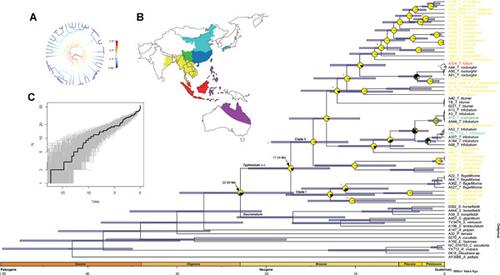当前位置:
X-MOL 学术
›
J. Syst. Evol.
›
论文详情
Our official English website, www.x-mol.net, welcomes your
feedback! (Note: you will need to create a separate account there.)
Extensive Miocene speciation in and out of Indochina: The biogeographic history of Typhonium sensu stricto (Araceae) and its implication for the assembly of Indochina flora
Journal of Systematics and Evolution ( IF 3.4 ) Pub Date : 2020-09-23 , DOI: 10.1111/jse.12689 Shook Ling Low 1, 2 , Chih‐Chieh Yu 1, 2 , Im Hin Ooi 3 , Wichan Eiadthong 4 , Alan Galloway 5 , Zhe‐Kun Zhou 1, 2, 6 , Yao‐Wu Xing 1, 2
Journal of Systematics and Evolution ( IF 3.4 ) Pub Date : 2020-09-23 , DOI: 10.1111/jse.12689 Shook Ling Low 1, 2 , Chih‐Chieh Yu 1, 2 , Im Hin Ooi 3 , Wichan Eiadthong 4 , Alan Galloway 5 , Zhe‐Kun Zhou 1, 2, 6 , Yao‐Wu Xing 1, 2
Affiliation

|
The Asian paleotropical flora is characterized by abundance of endemic species, high biodiversity, and complex geological and climatic histories. However, the main driving mechanism underlying such high tropical biodiversity remains unclear. Hence, the present study aimed to investigate the biogeographic origin of the Asian paleotropical flora by tracking the speciation and diversification history of a typical tropical perennial, Typhonium sensu stricto (s.s.) (Araceae), using a time-calibrated whole-plastome phylogeny. In particular, we tested whether the Asian paleotropic region is a macroevolutionary source or sink. We observed that Typhonium s.s. originated in Indochina during the early–middle Miocene epoch, ca. 17.24 Ma (95% highest posterior density [HPD]: 12.83 ̶ 21.99 Ma). Most of the in situ diversification within the genus Typhonium s.s. has been underway since 14.73 Ma, with an accelerated lineage diversification at ca. 15−17 Ma, which may have been triggered by the intensification of the Asian monsoon system around the middle Miocene. Furthermore, the underground tuberous stem of Typhonium s.s. might have played an essential role in the adaptation to the seasonality caused by the monsoon in Indochina. Our results also suggested that peripatric speciation may be important in the diversification of T. trilobatum and T. roxburghii. This study provides a framework for studies in biogeography and evolution of the Asian paleotropical flora.
中文翻译:

印度支那内外广泛的中新世物种形成:狭风台风菌(天南星科)的生物地理历史及其对印度支那植物群的影响
亚洲古热带植物群的特点是特有物种丰富、生物多样性高、地质和气候历史复杂。然而,这种高热带生物多样性背后的主要驱动机制仍不清楚。因此,本研究旨在通过使用时间校准的全塑性体系统发育追踪典型热带多年生植物Typhonium sensu stricto ( ss . ) (天南星科)的物种形成和多样化历史,来研究亚洲古热带植物群的生物地理起源。特别是,我们测试了亚洲古热带地区是宏观进化源还是汇。我们观察到Typhonium ss. 起源于中新世早中期的印度支那,约。17.24 Ma(95% 最高后密度 [HPD]:12.83 ̶ 21.99 Ma)。Typhonium ss属内的大部分原位多样化。自 14.73 Ma 以来一直在进行中,在大约 14.73 Ma 加速谱系多样化。15-17 Ma,这可能是由中中新世附近亚洲季风系统的加强引发的。此外,Typhonium ss的地下块茎茎。可能在适应印度支那季风引起的季节性方面发挥了重要作用。我们的研究结果还表明,周缘物种形成可能对三叶草和刺梨的多样化很重要. 本研究为亚洲古热带植物群的生物地理学和进化研究提供了一个框架。
更新日期:2020-09-23
中文翻译:

印度支那内外广泛的中新世物种形成:狭风台风菌(天南星科)的生物地理历史及其对印度支那植物群的影响
亚洲古热带植物群的特点是特有物种丰富、生物多样性高、地质和气候历史复杂。然而,这种高热带生物多样性背后的主要驱动机制仍不清楚。因此,本研究旨在通过使用时间校准的全塑性体系统发育追踪典型热带多年生植物Typhonium sensu stricto ( ss . ) (天南星科)的物种形成和多样化历史,来研究亚洲古热带植物群的生物地理起源。特别是,我们测试了亚洲古热带地区是宏观进化源还是汇。我们观察到Typhonium ss. 起源于中新世早中期的印度支那,约。17.24 Ma(95% 最高后密度 [HPD]:12.83 ̶ 21.99 Ma)。Typhonium ss属内的大部分原位多样化。自 14.73 Ma 以来一直在进行中,在大约 14.73 Ma 加速谱系多样化。15-17 Ma,这可能是由中中新世附近亚洲季风系统的加强引发的。此外,Typhonium ss的地下块茎茎。可能在适应印度支那季风引起的季节性方面发挥了重要作用。我们的研究结果还表明,周缘物种形成可能对三叶草和刺梨的多样化很重要. 本研究为亚洲古热带植物群的生物地理学和进化研究提供了一个框架。









































 京公网安备 11010802027423号
京公网安备 11010802027423号